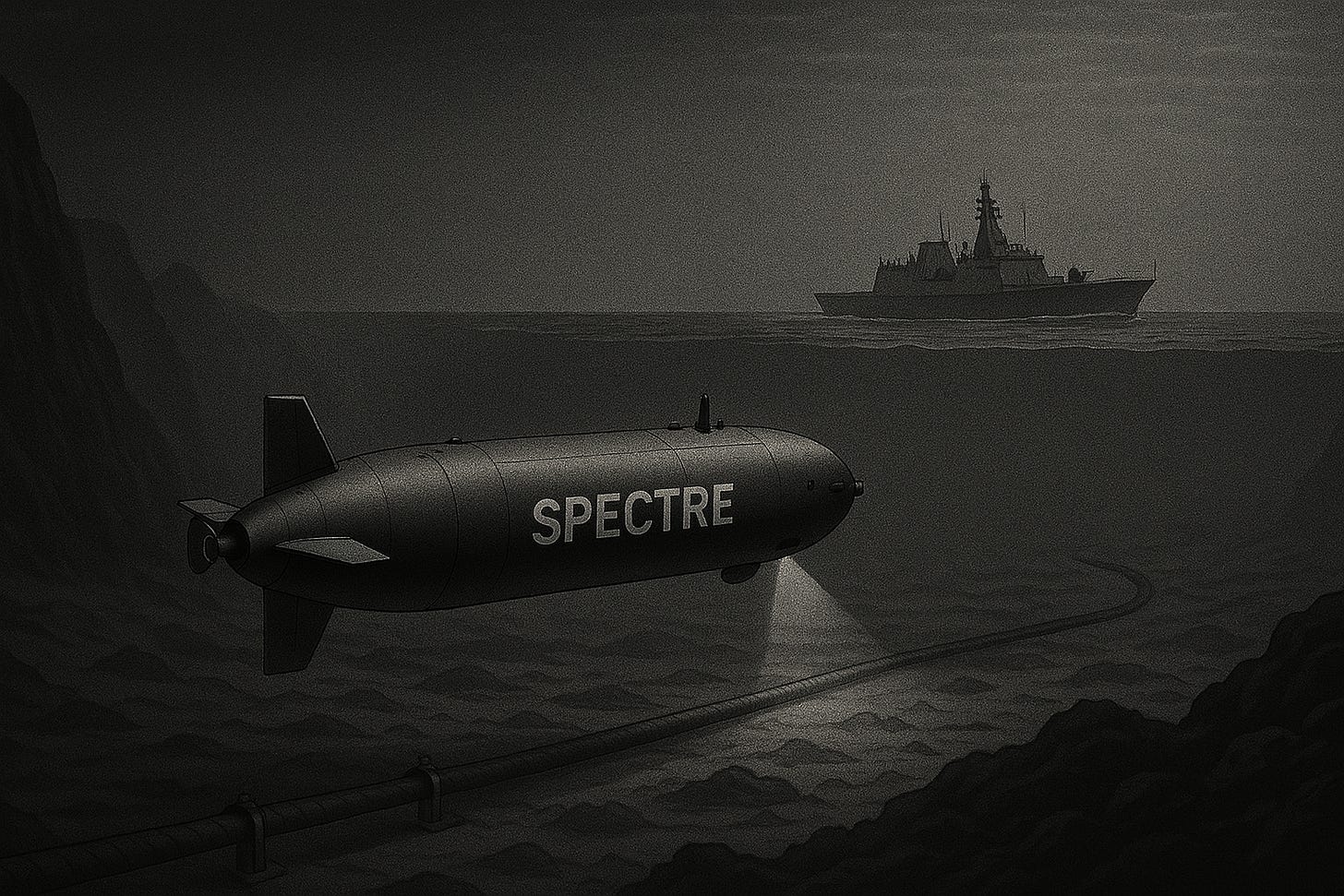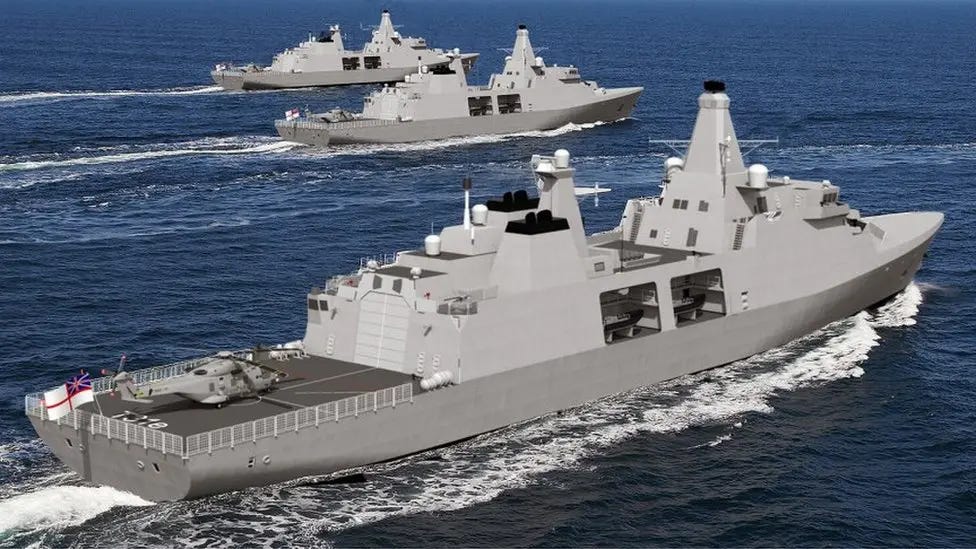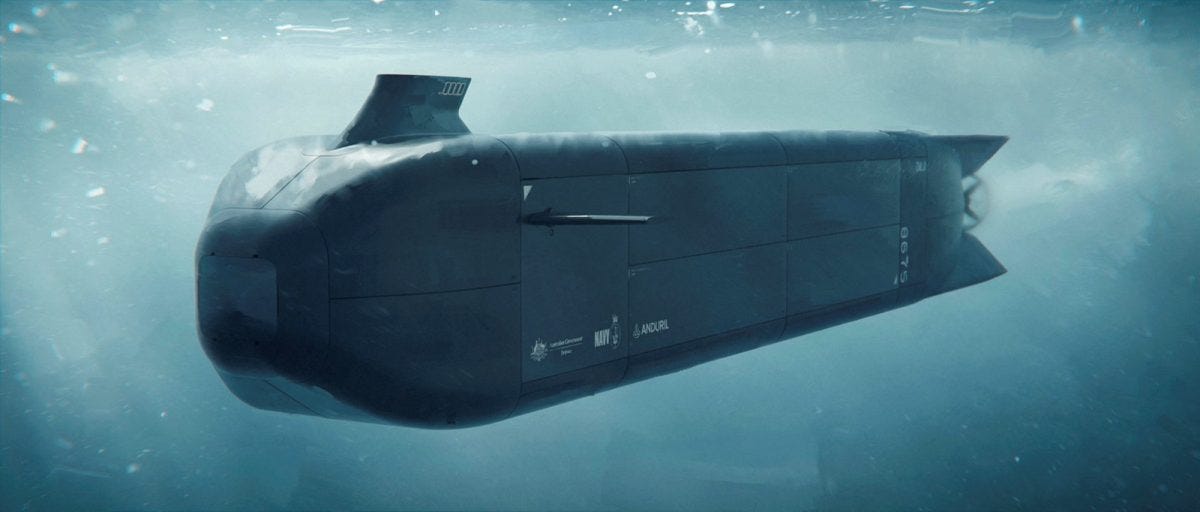Project Spectre: Britain's Deep-Sea Guardian
A Call to Urgent Action: Securing the Seabed in an Age of Strategic Disruption
Available as a deepdive podcast - click link
From the South Atlantic to the GIUK Gap, the underwater domain is no longer a sanctuary; it has become a contested battleground. The UK's 2025 Strategic Defence Review (SDR) appropriately emphasises the importance of resilience, autonomy, and digital force transformation. However, it is the often-overlooked seabed where this vision must truly take root. As geopolitical competition escalates and undersea infrastructure becomes a primary target, the question is not whether adversaries will strike below the surface, but rather when they will do so.
The stakes are monumental: seventeen transatlantic fibre optic cables connect the UK to the global internet, accounting for 98% of the country's digital communications. There have already been instances of sabotage in deep water, ranging from the Shetlands to the Baltic Sea. Russia's GUGI fleet, Chinese seabed surveillance operations, and unmarked commercial vessels all blur the lines between research and reconnaissance.
To deter, detect, and dominate in this space, Britain urgently requires not only advanced sensors but also sovereign capabilities in seabed operations. This is where Future Navy's Project Spectre proposal, of utmost importance, comes into play.
Dive into the depths of innovation with Project Spectre, a groundbreaking initiative designed to protect Britain's vast underwater territories. This ambitious endeavour aims to enhance maritime security and safeguard our oceans against emerging threats. With a blend of cutting-edge technology and strategic foresight, Project Spectre positions Britain as a formidable guardian of the deep seas. Explore how this project will reshape our naval capabilities, ensuring that we remain vigilant stewards of the blue frontier. Join us as we unveil the future of maritime defence and the vital role it plays in protecting our nation's interests beneath the waves.
Anduril: AI Warfare Comes Ashore in Britain
Anduril Industries, a leading defence tech company, has established a strong presence in the UK. Known for its autonomous drones, battlefield AI, and uncrewed underwater platforms, Anduril has formed integrated partnerships with British firms. Their latest UK initiative sees Anduril team up with Archer, a UK surveillance and security provider; Skyports Drone Services, specialising in autonomous drone operations; and AtkinsRéalis, a defence engineering heavyweight. Together, they're demonstrating AI-powered coastal and border surveillance using persistent aerial drones and Anduril's Lattice AI. This very battle network also drives their uncrewed underwater systems. These trials, aimed at supporting Home Office and MOD maritime security missions, confirm what matters most for Project Spectre: Anduril's AI technology is already operating within the UK defence ecosystem.
This provides the UK with an immediate, regulatory-clear, and technically proven foundation upon which to build a sovereign adaptation of Anduril's most secretive capability: the extra-large underwater vehicle known as Ghost Shark, currently in service with the Australian government.
Future Navy call our version: Project Spectre.
Introducing Project Spectre
Built on Anduril's proven XLUUV platform — known as Ghost Shark in Australian service — Project Spectre is a proposal for a UK-specific, sovereign undersea capability. Spectre would provide Britain with Deepwater autonomous patrol and reconnaissance, as well as persistent surveillance of undersea cables and seabed infrastructure. It would offer a modular, AI-enabled platform compatible with NATO and AUKUS architectures, and ensure immediate operational readiness using proven technology.
What Spectre Offers
Capability Detail Depth operates at depths of up to 6,000 metres, ideal for Atlantic cable patrol. Endurance allows for 10 days submerged, with no human crew required. Modularity includes payloads for sonar, ISR, loitering munitions, or seabed sensors. AI-driven operations controlled via Lattice AI, which has already been trialled in the UK & NATO environments. Communication & Control employs JANUS, acoustic modems, surface buoys, and satellite uplinks. The deployment platform is compatible with Type 31 frigates and RFA Proteus-class vessels. UK fit-out includes sovereign payloads, such as SAS sonar, secure communications, and SeeByte/BAE sensor fusion.
A Natural Fit for Project Cabot
Project Cabot is the Royal Navy's blueprint for the future of anti-submarine warfare. It shifts from ship-bound sonar to a network of uncrewed, autonomous sensors and AI-led situational awareness. Project Spectre doesn't just support Cabot — it completes it. It acts as a mobile, persistent deep-sea node in Cabot's surveillance web, providing real-time threat intelligence across the seabed domain. It uses existing NATO and AUKUS protocols for multi-domain data sharing. Spectre brings sovereign payload options while accelerating time to field. Spectre is not experimental — it's already operational, just not yet under a British flag.
Type 31: The Mothership for Spectre
The Inspiration-class Type 31 frigates are being built with open architecture and modularity in mind. They're the ideal launch and control hub for Spectre, featuring large flight decks and mission bays for containerised control centres, space for modular LARS (Launch and Recovery Systems), and a design tailored to operate uncrewed systems and offboard sensors. Pairing Spectre with Type 31 gives the Royal Navy low-profile, deep-sea overwatch, especially in the GIUK Gap and across transatlantic cable routes.
Why Licence, Not Build?
While the UK's Excalibur UUV shows promise, it's still in prototype trials. Spectre, based on the Ghost Shark design, is already deployed in Australia and is currently on trial with the US. It is modular and configurable for UK sensors and missions. Licensing Spectre for UK adaptation offers several advantages over building from scratch, including faster deployment, reduced development costs, and access to proven technology. This approach allows the UK to leverage existing capabilities and focus on integrating Spectre into its defence strategy.
Conclusion
This approach is low-risk, and in a time of war preparation, this is important. In the summer of 1990, I stood on the operations room floor of HMS Norfolk — the first of the Royal Navy's new Type 23 frigates — as we prepared to fire her first Sea Wolf missile. But unlike what you might expect from a cutting-edge warship, we weren't using a fully integrated combat management system. There wasn't one. The Royal Navy had commissioned a new class of ships without the digital command infrastructure they truly needed.
That day, we launched the missile using a modified personal computer interfaced directly with the GWS-26 Sea Wolf system. I know this because I was the warfare specialist who pulled the trigger on that first shot, on a test range off the Welsh coast. It worked — just barely — but it stood as a stark reminder of how procurement delays, shifting requirements, and overly complex bureaucracy can cripple innovation at the very moment it's most needed. This is why companies like Anduril, with their agile, mission-driven engineering model, feel like such a refreshing — and necessary — break from the past.




